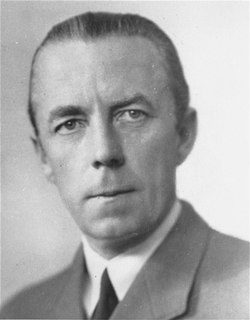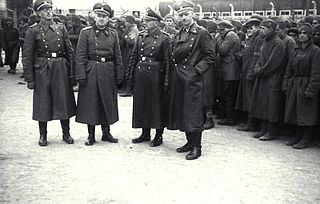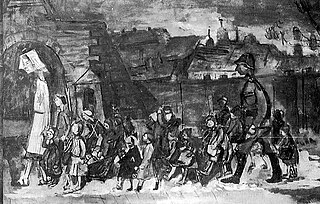
The Auschwitz concentration camp was a complex of over 40 concentration and extermination camps built and operated by Nazi Germany in occupied Poland during World War II and the Holocaust. It consisted of Auschwitz I, the main camp (Stammlager) and administrative headquarters, in Oświęcim; Auschwitz II–Birkenau, a combined concentration/extermination camp three kilometers away in Brzezinka; Auschwitz III–Monowitz, a labor camp seven kilometers from Auschwitz I, set up to staff an IG Farben synthetic-rubber factory; and dozens of other subcamps.

The Final Solution or the Final Solution to the Jewish Question was a Nazi plan for the genocide of Jews during World War II. The "Final Solution of the Jewish Question" was the official code name for the murder of all Jews within reach, which was not restricted to the European continent. This policy of deliberate and systematic genocide starting across German-occupied Europe was formulated in procedural and geo-political terms by Nazi leadership in January 1942 at the Wannsee Conference held near Berlin, and culminated in the Holocaust, which saw the killing of 90% of Polish Jews, and two thirds of the Jewish population of Europe.

Nazi Germany built extermination camps during the Holocaust in World War II, to systematically kill millions of Jews, Slavs, Poles, Roma, Soviet POWs, political opponents and others whom the Nazis considered "Untermenschen" ("subhumans"). The victims of death camps were primarily killed by gassing, either in permanent installations constructed for this specific purpose, or by means of gas vans. Some Nazi camps, such as Auschwitz and Majdanek, served a dual purpose before the end of the war in 1945: extermination by poison gas, but also through extreme work under starvation conditions.

Folke Bernadotte, Count of Wisborg was a Swedish diplomat and nobleman. During World War II, he negotiated the release of about 31,000 prisoners from German concentration camps, including 450 Danish Jews from the Theresienstadt camp. They were released on 14 April 1945. In 1945, he received a German surrender offer from Heinrich Himmler, though the offer was ultimately rejected.

Bergen-Belsen[ˈbɛʁɡn̩.bɛlsn̩], or Belsen, was a Nazi concentration camp in what is today Lower Saxony in northern Germany, southwest of the town of Bergen near Celle. Originally established as a prisoner of war camp, in 1943, parts of it became a concentration camp. Initially this was an "exchange camp", where Jewish hostages were held with the intention of exchanging them for German prisoners of war held overseas. The camp was later expanded to accommodate Jews from other concentration camps.

Majdanek, or KL Lublin, was a German concentration and extermination camp built and operated by the SS on the outskirts of the city of Lublin during the German occupation of Poland in World War II. Although initially purposed for forced labor rather than extermination, the camp was used to kill people on an industrial scale during Operation Reinhard, the German plan to murder all Jews within their own General Government territory of Poland. The camp, which operated from October 1, 1941, until July 22, 1944, was captured nearly intact, because the rapid advance of the Soviet Red Army during Operation Bagration prevented the SS from destroying most of its infrastructure, and the inept Deputy Camp Commandant Anton Thernes failed in his task of removing incriminating evidence of war crimes. Therefore, Majdanek became the first concentration camp discovered by Allied forces. Also known to the SS as Konzentrationslager (KL) Lublin, Majdanek remains the best-preserved Nazi concentration camp of the Holocaust.

Dachau concentration camp was the first of the Nazi concentration camps opened in 1933, intended to hold political prisoners. It is located on the grounds of an abandoned munitions factory northeast of the medieval town of Dachau, about 16 km (10 mi) northwest of Munich in the state of Bavaria, in southern Germany. Opened by Heinrich Himmler, its purpose was enlarged to include forced labor, and eventually, the imprisonment of Jews, German and Austrian criminals, and eventually foreign nationals from countries that Germany occupied or invaded. The Dachau camp system grew to include nearly 100 sub-camps, which were mostly work camps or Arbeitskommandos, and were located throughout southern Germany and Austria. The camps were liberated by U.S. forces on 29 April 1945.

Nazi Germany maintained concentration camps throughout the territories it controlled before and during the Second World War. The first Nazi camps were erected in Germany in March 1933 immediately after Hitler became Chancellor and his Nazi Party was given control of the police by Reich Interior Minister Wilhelm Frick and Prussian Acting Interior Minister Hermann Göring. Used to hold and torture political opponents and union organizers, the camps initially held around 45,000 prisoners. In 1933–1939, before the onset of war, most prisoners consisted of German Communists, Socialists, Social Democrats, Roma, Jehovah's Witnesses, homosexuals, and persons accused of 'asocial' or socially 'deviant' behavior by the Germans.

SS-Totenkopfverbände (SS-TV), literally translated as Death's Head Units, was the SS organization responsible for administering the Nazi concentration camps and extermination camps for Nazi Germany, among similar duties. While the Totenkopf (skull) was the universal cap badge of the SS, the SS-TV also wore the Death's Head insignia on the right collar when needed; to distinguish itself from other Nazi Schutzstaffel (SS) formations.
Richard Glücks (help·info) was a high-ranking German Nazi official in the SS. From November 1939 until the end of World War II, he was Concentration Camps Inspector (CCI), which became Amt D: Konzentrationslagerwesen under the WVHA in Nazi Germany. As a direct subordinate of Heinrich Himmler, he was responsible for the forced labour of the camp inmates, and was also the supervisor for the medical practices in the camps, ranging from human experimentation to the implementation of the "Final Solution", in particular the mass murder of inmates with Zyklon-B gas. After Germany capitulated, Glücks committed suicide by swallowing a potassium cyanide capsule.

Joel Brand was a leading member of the Aid and Rescue Committee, an underground Zionist group in Budapest, Hungary, that smuggled Jews out of German-occupied Europe during the Holocaust to the relative safety of Hungary. When Germany invaded that country too in March 1944, Brand became known for his efforts to save the Jewish community from deportation to the Auschwitz concentration camp in German-occupied Poland.

Herzogenbusch concentration camp was a Nazi concentration camp located in Vught near the city of 's-Hertogenbosch, Netherlands. Herzogenbusch was, with Natzweiler-Struthof in occupied France, the only concentration camp run directly by the SS in western Europe outside Germany. The camp was first used in 1943 and held 31,000 prisoners. 749 prisoners died in the camp, and the others were transferred to other camps shortly before the camp was liberated by the Allied Forces in 1944. After the war the camp was used as a prison for Germans and Dutch collaborators. Today there is a visitors' center with exhibitions and a national monument remembering the camp and its victims. The camp is now a museum.

The issue of why Auschwitz concentration camp was not bombed by the Allies during World War II continues to be explored by historians.
Events in the year 1945 in Germany. Many events took place in 1945. Including the change of the geographical map of Germany

Death marches refers to the forcible movements of prisoners of Nazi Germany between Nazi camps during World War II. They occurred at various points during the Holocaust, including 1939 in the Lublin province of Poland, in 1942 in Reichskommissariat Ukraine and across the General Government, and between Autumn 1944 and late April 1945 near the Soviet front, from the Nazi concentration camps and prisoner of war camps situated in the new Reichsgaue, to camps inside Germany proper, away from reach of the Allied forces. The purpose was to remove evidence of crimes against humanity committed inside the camps and to prevent the liberation of German-held prisoners of war.

Ravensbrück was a German concentration camp exclusively for women from 1939 to 1945, located in northern Germany, 90 km (56 mi) north of Berlin at a site near the village of Ravensbrück. The largest single national group consisted of 40,000 Polish women. Others included 26,000 Jewish women from various countries: 18,800 Russian, 8,000 French, and 1,000 Dutch. More than 80 percent were political prisoners. Many slave labor prisoners were employed by Siemens & Halske. From 1942 to 1945, medical experiments to test the effectiveness of sulfonamides were undertaken.

On 21 August 1943, during the liquidation of the Białystok Ghetto, about 1,200 Jewish children were put on trains and taken to Theresienstadt concentration camp, where they were held in isolation from other prisoners. On 5 October, they were told that they would be sent to Switzerland in exchange for German prisoners of war. Instead, the train went to Auschwitz concentration camp where all were murdered in gas chambers. The reason for the unusual route of the transport is still debated by scholars; it is believed to be connected to Nazi–Jewish negotiations ongoing at the time and the intervention of Mohammad Amin al-Husseini, who feared that the children would settle in Palestine.

















